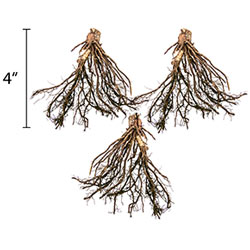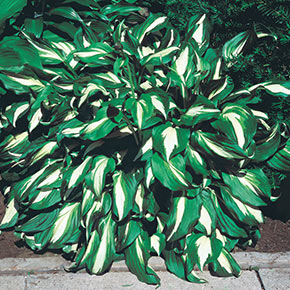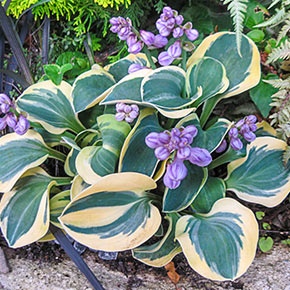-
Spring Planting
Order now for best selections.
-
Fall Planting
Available for preorder for fall 2025 delivery.
-
Bulk Flower Bulbs
Big savings on bulk orders!
- New
-
Gardening Resources
Flower Bulbs & Perennials at Wholesale Prices

How to Plant, Grow, and Care For Hostas
| Botanical Name | Hosta |
| Plant Type | Herbaceous perennial |
| Sun Exposure | Part shade, full shade |
| Soil Type | Well-drained, loamy, sandy or clay soils |
| Soil pH | Slightly acidic to neutral |
| Bloom Time | Mid to late summer |
| Foliage Color | Blue-green, green, yellow-green, variegated, white |
| Hardiness Zones | 3-9 |
| Special Features | Container friendly. Available in range of sizes. |
Hostas are the most popular shade perennials and with good reason. They're easy to grow, require very little maintenance and are available in so many shades and sizes. The garden design possibilities are endless.
Grown primarily for their foliage, which can be variegated, puckered or crinkled, most hostas grow best with less than six hours of direct sunlight daily. While most perform well in dappled sunlight or morning sunlight, many varieties can't handle direct afternoon sunlight. Depending on the variety, hostas range in height from 4 inches to 4 feet. In the garden, hostas are favorites for woodland gardens, container gardening, rock gardens, accent plants, ground covers and for lining walkways and borders.
Once gardeners start growing hostas, they're on the lookout for interesting varieties and more ways to incorporate them into their garden designs.

How to Plant Hostas
If planting bareroots, soak the roots in water for about 30 minutes before planting. If the soil is sandy or clay, mix in compost. Dig a hole that is about twice the size of the root ball. Place the plant in the hole. Spread the roots outward as well as downward so that they can start to grow and establish themselves. If the plant has a large crown, set the crown on a little mound of firm soil in the center of the hole, allowing the roots to trail down. Always plant hostas at the same depth at which they were growing in the pot or nursery. Fill in around the plant with soil, gently firming with the palms of your hands to eliminate any air pockets, but not so heavily as to compact the soil. Mulch with several inches of organic mulch to conserve water and keep weeds from growing. Water well.
Materials You'll Need
For digging, you'll need a shovel or trowel. If planting in containers, make sure the container provides adequate drainage. Without drainage, the plants will rot. Hostas benefit from an all-natural, slow-release fertilizer, such as Van Bourgondien 100% Natural Perennial Food.
When to Plant Hostas
Hostas can be planted in the spring or the fall. Avoid planting in the heat of the summer, as the summer heat and often dry ground makes it more difficult for the plants to establish themselves. Likewise, they shouldn't be planted in the winter months when the ground is cold or frozen.
Where to Plant Hosta Bulbs
Hostas grow in zones 3-9 and can be grown throughout much of the United States, except for the extreme northern or southern regions. You can find your grow zone using our zone finder.
Hostas prefer shade or filtered light. For many varieties, morning sun and afternoon shade is best. Generally, blue-leaved hostas require shadier conditions while a little more sun brings out the color in gold and light green varieties. The White Feather Hosta requires full shade.
While hostas will grow in sandy, loamy or clay soils, it must be well-drained. To improve drainage in sandy or clay soils, mix in plenty of compost. Hostas perform best in moist soils, not wet soils.
Hostas are often grown with spring flowering bulbs, such as daffodils, and other shade perennials, including dicentra and ferns. When planting hostas, note their mature height and spread. Most hostas take a few years to reach their full size. Avoid overcrowding them.
How to Grow & Care For Hostas
Once established, hostas don't require a lot of care. In the springtime, fertilize with a slow-release, all-natural fertilizer. If using a granular plant food, don't allow it to sit on the leaves. Hostas growing in containers may require more fertilizer.
Hostas have average water needs. While they like moist soil, they can handle a dry spell, once established. If dry, water deeply. Hostas growing in containers require more frequent watering.
Once the flowers fade, cut the flower stems off at their base. Allow the foliage to fade in the fall. Removing spent leaves may help control pests and slugs.
When Do Hostas Bloom?
While grown primarily for their foliage, hostas bloom from midsummer to early fall, depending on the variety. The fragrant flowers open on tall stems above the foliage and attract pollinators. Young hosta plants and those grown in heavy shade may not flower as much as other hostas, or they may not flower at all.
Transplanting & Splitting
Hostas rarely need to be divided. However, if you want to grow more or share with friends, the clumps may be divided. The best time to do this is in the fall or early spring. Just dig up the root ball and split off part of the root ball. Then replant.
Pests & Diseases
While hostas are fairly trouble free, some pests and diseases bother them. Crown rot is the most common disease. Symptoms include yellowing or browning leaves and mushy, rotted crowns. The most common pests are slugs, rabbits and deer. Slugs and snails will chew on leaves. Some hosta varieties are more slug resistant. Other control measures include hand picking, traps and bait. Fencing may keep hungry rabbits out.
How to Keep Deer From Eating Hostas
Deer like to munch on hostas. If deer are a problem, some strategies include planting deer-resistant plants, such as daffodils, near the hostas. Deer repellents and motion sensors may also be effective. Tall fencing is also used to keep deer out of garden. Keep in mind that measures that work in one area may not work in others.
FAQs
How Long Do Hostas Live?
Once established, hostas are long-lived perennials and can live for 25 years or even longer.When To Cut Back Hostas
When the flowers fade, remove the spent flower to create a tidy appearance. The foliage will remain attractive through fall.What Do Hostas Look Like in The Winter?
Hostas go dormant in the winter and appear as mounds with faded, brown leaves. They may look like they've died.How Big Do Hostas Get?
Depending on the variety, hostas may grow to 4 inches to up to 4 feet. When buying hostas, check the variety's mature height and spread.Types of Hostas
With hundreds of varieties available, many ask how to decide what hostas to buy. Some favorites are listed below and provide an idea of the color ranges and sizes of hostas.
Hosta Hyacinthina: Features ribbed green foliage and grows 18-24" tall. It naturalizes well and is excellent for mass planting. Just plant it and enjoy its sparkling color for years to come.

Hosta Mediovariegata: One of the best of the variegated hostas, its wavy, green leaves with white centers brighten shade gardens and container plantings. Growing 18-24" tall, it's a great accent plant.

Hosta Bressingham Blue: Puckered, deeply ridged, blue-green leaves give shade gardens and mixed container plantings a unique look. Growing 30" tall, Bressingham Blue is one of the best blue-green hostas available.

Mini Hosta Mighty Mouse: Mini hostas add charm and color to container plantings and smaller garden spaces, and this is one of our favorites. Growing 4-5" tall, it features round, blue-green leaves with yellow margins.
| Shop All Shade Perennials | |
| See More Tips |
Have another question? Return to the Customer Service Help page or send an e-mail directly to Customer Service
Copyright © 2025 Gardens Alive!, Inc. d/b/a Dutchbulbs.com. All Rights Reserved. Dutchbulbs.com trademarks are registered trademarks of Gardens Alive!, Inc.
This site is protected by reCAPTCHA and Google Privacy Policy and Terms apply.
This site is protected by reCAPTCHA and Google Privacy Policy and Terms apply.

Item added to cart





